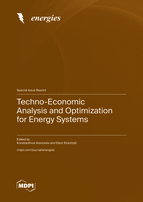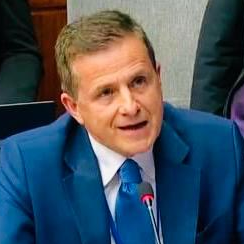Techno-Economic Analysis and Optimization for Energy Systems
A special issue of Energies (ISSN 1996-1073). This special issue belongs to the section "C: Energy Economics and Policy".
Deadline for manuscript submissions: closed (31 December 2023) | Viewed by 19986
Special Issue Editors
Interests: analysis and evaluation of investments for technical projects (cost-benefit analysis (CBA), analysis throughout the project life cycle (LCA), multi-criteria analysis); risk management; engineering economics; environmental economics; environmental planning; circular economy; evaluation of environmental investments with applications in operational research; planning, management and evaluation of environmental investments; evaluation of technological investments through life cycle analysis (LCA) and cost-benefit analysis (CBA); planning and evaluation of corporate social responsibility (CSR) in companies; planning and evaluation of projects for public private partnerships (PPPs)
Special Issues, Collections and Topics in MDPI journals
Interests: techno-economic analysis of investments; decision support systems–multicriteria analysis; energy planning; maritime supply chain; maritime transport and environment; circular economy; environmental risk assessment; smart cities; startup enterprises
Special Issues, Collections and Topics in MDPI journals
Special Issue Information
Dear Colleagues,
The challenges of climate change and energy transition require fundamental changes in energy systems. Significant progress is necessary so that today's energy systems change toward satisfying the ambitious targets of the Energy Roadmap 2050 of the European Commission for fully decarbonizing the European economy by reducing GHG emissions in developed countries to below 80–95% of 1990 levels by 2050. A circular economy has risen high in the agendas of policymakers as a way of enhancing the decarbonization approach.
Conventional Techno-Economic Analysis has been used throughout the decades, as an important decision support tool to evaluate the technical performance and economic feasibility of a technology or a process. It is also usually combined with optimization techniques finding the “action” that best achieves a desired goal or objective. Recent research has begun to incorporate data-driven technologies into Techno-Economic Analysis to effectively optimize both processes and economic parameters simultaneously.
Based on the above, this Special Issue calls for papers broadly related to techno-economic analysis and optimization approaches, especially for energy systems, taking into account circular economy principles. Recent theoretical and methodological advancements, review papers with critical analysis, case studies, applications, technical contributions, and applications of tools and techniques to improve techno-economic analysis and optimization are all welcome. Specific topics of interest include, but are not limited to, the following:
- Decarbonized energy systems, shipping decarbonization
- Design and control of energy systems
- Optimal energy management
- Sustainable ship energy systems
- Hybrid, power to X energy systems
- Renewable energy and synthetic fuels as replacement of fossil fuels: methanol, ammonia, hydrogen
- Energy storage systems
- Energy systems reliability and energy security
- Smart energy systems
- Global, international, regional, national, and local energy systems
- LNG as transient fuel in energy sector and shipping
- Green Hydrogen Economy
Prof. Dr. Konstantinos Aravossis
Dr. Eleni Strantzali
Guest Editors
Manuscript Submission Information
Manuscripts should be submitted online at www.mdpi.com by registering and logging in to this website. Once you are registered, click here to go to the submission form. Manuscripts can be submitted until the deadline. All submissions that pass pre-check are peer-reviewed. Accepted papers will be published continuously in the journal (as soon as accepted) and will be listed together on the special issue website. Research articles, review articles as well as short communications are invited. For planned papers, a title and short abstract (about 100 words) can be sent to the Editorial Office for announcement on this website.
Submitted manuscripts should not have been published previously, nor be under consideration for publication elsewhere (except conference proceedings papers). All manuscripts are thoroughly refereed through a single-blind peer-review process. A guide for authors and other relevant information for submission of manuscripts is available on the Instructions for Authors page. Energies is an international peer-reviewed open access semimonthly journal published by MDPI.
Please visit the Instructions for Authors page before submitting a manuscript. The Article Processing Charge (APC) for publication in this open access journal is 2600 CHF (Swiss Francs). Submitted papers should be well formatted and use good English. Authors may use MDPI's English editing service prior to publication or during author revisions.
Keywords
- techno-economic analysis
- optimization models
- energy systems
- circular economy
- sustainability
- energy transition
- decarbonization
- energy system components
- alternative fuels







